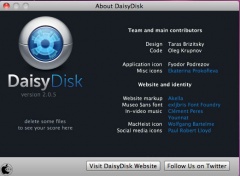

- #Daisydisk app store for free
- #Daisydisk app store full
- #Daisydisk app store download
- #Daisydisk app store mac
#Daisydisk app store mac
Your Mac will grumble the first time you try to launch OpenEmu. Just watch those chunky pixels don’t take an eye out.

There’s also an ‘experimental’ version that adds a load of additional systems, including arcade. If you’ve previously delved into the horrors of emulation, OpenEmu’s ‘it just works’ mentality will appeal.

Controllers can be configured, and then you can play.
#Daisydisk app store download
Point it at your games and it’ll download cover art. Fortunately, OpenEmu is one of the best on any platform. The Mac’s not exactly drowning in emulators when you want to get your retro gaming on. And being able to flag books as ‘loaned’ means you should never again lose a precious volume to a forgetful friend.īuy Book Tracker (£free + £9.49, Mac App Store) OpenEmu

You can track what you’re currently reading and note down what you thought when you were done. Log your collection in the app by bar-code scans or online searches, and then tag/organise as you see fit. If you often guiltily look at piles of unread books around your home, glance at digital books installed on devices, and then decide to buy yet more books (because, hey, more books), Book Tracker is a must.
#Daisydisk app store for free
The app generously gives you all this for free but lob the creator a fiver and you unlock filtering options and can follow record labels.īuy MusicHarbor (£free or £4.99, Mac App Store) Book Tracker Promo videos are available too, like your own personalised MTV. The app then shows latest and upcoming releases, which you can preview or add to your library. You ‘import’ artists from Music or add them manually. Handily, MusicHarbor does that job brilliantly. MusicHarborĪpple’s Music app is fine for playback and surfacing new tunes you’ll like, but it’s rubbish at keeping tabs on favourite artists. In particular, the new DaisyDisk cuts down the amount of hidden space by revealing some obscure system items such as non-linked content of the 'firmlinked' Data volume (under /System/Volumes/Data), the virtual memory volume (under /private/var/VM) and some other.When life shifts from work to play, use these apps to entertain yourself. Thankfully, the new version of DaisyDisk (4.10) is making it much easier to reveal the macOS' hidden space, and for the part that cannot be revealed – understand its internal structure and even provide tools to reclaim it by demand. However, in certain cases, you just need to free up the space urgently, and it's quite confusing that you don't have control over a big chunk of your disk. This is how macOS Catalina works and it's not supposed to even be a problem or require any maintenance from the user. However, the backup process is continuous and therefore there is always a certain amount of disk space that is locked by macOS for the snapshots. Eventually when the snapshots get transferred to the permanent storage, such as the Time Capsule, or as the snapshots become too old and get replaced by newer ones, macOS releases the disk space. The reason for this problem is that macOS is making temporary backups of the system, so called local snapshots, temporarily locking big amounts of disk space in an area of the disk that is fully opaque to the users. The efficiency of DaisyDisk is also unmatched by the 'automatic cleaner' apps because as a rule, the latter are capable of freeing only up to 10 GBs or so.' DaisyDisk is priced at $9.99 and is. A quick scan in DaisyDisk typically reveals a big chunk of 'hidden space', which means the system is using more disk space than it's possible to reveal by scanning, even with elevated permissions (scanning 'as Administrator').
#Daisydisk app store full
DaisyDisk 4.10 adds support of APFS SnapshotsĮver since macOS Catalina was introduced, many Mac users noticed that their disks eventually get full without obvious reason.


 0 kommentar(er)
0 kommentar(er)
